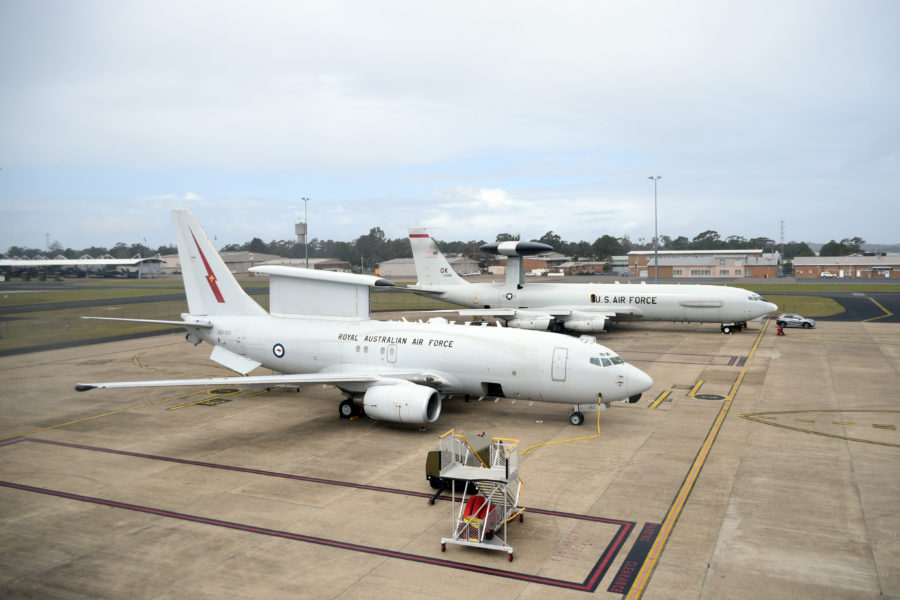The Air Force has taken the first step toward a rapid acquisition of Boeing’s E-7A Wedgetail airborne warning and control aircraft to replace the aging E-3 Sentry Airborne Warning and Control System, or AWACS, according to an Oct. 20 business opportunity announcement.
The Air Force announced it’s seeking information from Boeing to perform “studies, analyses, and activities required to ascertain the current E-7A baseline configuration and determine what additional work would be necessary” to make the aircraft compatible with Air Force “configuration standards and mandates.” It didn’t specify when it would be seeking the new airplane.
Senior Air Force leaders, at AFA’s Air, Space & Cyber conference in September, said they were looking favorably at replacing the E-3 with the Wedgetail, given its lower operating cost and non-developmental status. Air Combat Command chief Gen. Mark D. Kelly told reporters that to maintain “707-based” aircraft such as the E-3 is no longer feasible. Kelly said he anticipated no significant issues making the E-7 compatible with USAF needs, especially since it was designed and developed in the U.S.
The Air Force, alone among its allies, does not “field a cutting-edge, air-moving-target-indicator capability,” Kelly lamented. Commenting on the AWACS’ age and maintenance issues, he said, “There’s a reason why exactly zero airlines around the globe fly the 707. Because it takes a miracle … every day just to get it up in the air.”
The Air Force has operated the E-3 AWACS since 1977, and since then, NATO, the U.K., France, and Saudi Arabia have acquired their own examples. Japan operates a similar system hosted aboard the 767 airframe. The last E-3 was built in 1992. The aircraft is used to provide long-range detection, tracking, and identification of airborne threats, as well as command and control of friendly fighters, vectoring them toward intercepts of hostile aircraft.
Chief of Staff Gen. Charles Q. Brown Jr., speaking at ASC21, said the E-7 provides “an option to be able to get the capability much faster than if we were to start a new one from scratch.” He called the E-7 “a good platform” that he flew, or flew aboard, twice during his time as commander of Pacific Air Forces. Air Force Secretary Frank Kendall said the E-7 “could be useful” to shore up the AWACS mission.
The Wedgetail, which uses a fixed blade-like antenna on a 737 airframe—rather than a rotating radome like on the 707-based E-3 Sentry—was developed for the Royal Australian Air Force starting in 1999 and has operated with that service since 2009. It has also been selected by the U.K., Korea, and Turkey to equip their air services, offering interoperability advantages.
Gen. Kenneth S. Wislbach, current PACAF commander, noted that the Wedgetail is “a proven capability” and that he’s been impressed with its performance.
Brown suggested that funding for the E-7 could show up in the fiscal 2023 budget; the Air Force did not release out-year budget plans with its 2022 budget, now before Congress. The Air Force has used new rapid acquisition authorities given by Congress in the last few years to jump-start various prototyping efforts, as well as the F-15EX procurement.
The government wants to evaluate information regarding “diminishing manufacturing sources,” systems engineering, cybersecurity, airworthiness, test data, “spectrum allocation” and “future impacts of Federal Communications Commission forecasted sales of spectrums,” open mission systems, and M-code GPS. It designated Boeing as the only potential supplier of the system.
“The Aircraft Rapid Prototyping Requirements Document [RPRD] has specifically called out the E-7A and it has been determined that this is a sole-source requirement,” the government said.
The Air Force had planned to replace the E-3 with a “distributed” system, similar to what it is pursuing with the Advanced Battle Management System replacing the E-8 Joint STARS, but it has not said anything along those lines since it completed the Sentry Block 40/45 upgrade in 2020. Brown, however, said at AFA’s conference that the ultimate goal is to have a capability “that can be defensible” and suggested that a space-based system could be a solution.
None of the USAF leaders who addressed the E-7 said anything about how many the Air Force might buy, but the service fields 31 E-3 AWACS.
Kelly said a derivative of the Navy’s E-2D Hawkeye, which is a turboprop-powered aircraft with a rotating radome like that on the E-3 AWACS, would not match USAF’s needs.
There is some urgency to getting a Wedgetail acquisition underway, as Boeing is eyeing an end to 737 Next-Generation—on which the E-7 is based—in the 2025 timeframe, hence the “diminishing manufacturing sources” information request. The Wedgetail has much in common with the Navy’s P-8 Poseidon maritime patrol aircraft, also in use by several other countries. Boeing pitched a P-8/737-based JSTARS replacement in 2015, but the Air Force dropped that effort in favor of the ABMS.
